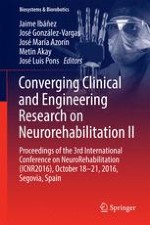2017 | OriginalPaper | Buchkapitel
Improving Upper Extremity Impairments with Tongue Driven Robotic Assisted Rehabilitation: A Pilot Study
verfasst von : S. N. Housley, D. Wu, S. Belagaje, M. Ghovanloo, A. J. Butler
Erschienen in: Converging Clinical and Engineering Research on Neurorehabilitation II
Aktivieren Sie unsere intelligente Suche, um passende Fachinhalte oder Patente zu finden.
Wählen Sie Textabschnitte aus um mit Künstlicher Intelligenz passenden Patente zu finden. powered by
Markieren Sie Textabschnitte, um KI-gestützt weitere passende Inhalte zu finden. powered by
